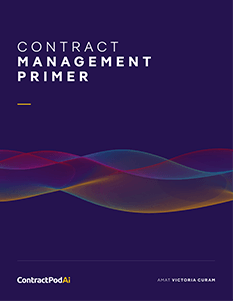EVERYTHING YOU NEED TO KNOW ABOUT CONTRACT MANAGEMENT FUNDAMENTALS
What is Contract Management?
Contract management (CM) is the process of creating, executing, and analyzing contracts. But beyond that superficial definition, what else do you need to know about contract management software and processes? What are the contract management fundamentals you need to learn to better understand your business and contract management needs?
Our Contract Management Primer defines what an end-to-end contract management system (CMS) should be. Best of all, it includes a very handy contract lifecycle management (CLM) checklist. Once you decide to automate, use this checklist to determine what you need in your CLM solution. Investing in CLM software is a step in the right direction. But it takes guided research. So, this checklist also offers questions you should ask before selecting legal technology vendors.
In-House Counsel Turning Point
We are at a crucial point in the legal industry. Between 50% and 60% of legal departments still use manual, complex systems to manage all agreements. If they do not store paper-based contracts in filing cabinets, which is not uncommon, they track contract data through Microsoft Excel spreadsheets. But when the average fortune 500 company has between 20,000 to 40,000 active contracts, a manual system places undue pressure on organizations and negatively affects deal flow. Sooner or later, it will fail you – and the company – when you can least afford it.
Learn more by filling out the short form – to the right – and getting your copy of our Contract Management Primer. This practical guide also tells you the pains a CLM solution solves, the phases of contract management, where artificial intelligence (AI) fits into the equation, and how to begin digitally transforming your department. That way, you can manage contracts as strategic assets, achieve better outcomes, and help drive greater business value.
The Pain it Solves
Failing to manage your company’s contracts effectively brings tremendous risks. Firstly, the sheer volume of active contracts is a pain onto itself. If small risks are triggered across many contracts, an organization can suffer the dreaded ‘death by a thousand cuts.’
An important part of risk management, then, is contract administration. Whether sell-side or buy-side, contracts are often hidden throughout a company. And misplacing contracts is one of the biggest risks of maintaining a manual or antiquated agreements system. Our valuable Contract Management Primer points out other contracting challenges, explaining what they mean, which risks they open your organization to, and how to mitigate them effectively:
- Slow contract turnaround
- Approval workflows that do not work
- Lack of consistency across contracts
- Lack of a common repository for agreements
- Low contract visibility
Who Needs an End-to-End Contract Management System?
Typically, the users of contract management software are:
- General counsels
- The Office of the General Counsel
- Legal teams
- Contract management teams
They can all use this guide to get a better picture of a proper contract management process: aligning contracts for consistency, maintaining key terms and conditions, adjusting contracts to particular contract terms, and keeping tabs on important dates and obligations. Basically, getting a pulse on agreements and the business.
But the contract management process extends beyond legal departments to sales teams and those in relationship management roles.
Download this guide – right now – to find out how.
Phases of Contract Lifecycle Management (CLM)
Also, learn about the importance of three key phases of agreements – and how they impact your part of the contract management process:
- Pre-contract phase
- Contract development, award, and execution phase
- Post-award phase
Artificial Intelligence (AI) In Your CLM System
Today’s CMS providers all promote their solutions as being equipped with artificial intelligence. But why is AI so important to the contract management process? And is all AI made equally, or do some stand ahead of others? One of the challenges of the legal industry is assessing AI capabilities – and deciding whether to adopt systems built on partnership AI platforms from industry leaders like IBM Watson.
Contract Management Primer – Checklist
As state above, our Contract Management Primer concludes with a handy checklist. Those in the GC’s office, legal operations, project management, and procurement can use this as a strategic sourcing guide. It provides a number of considerations to take into account while starting to review contract management software vendors.
Get a copy of this guide to have a checklist of your own.
Guide to Contract Lifecycle Management Fundamentals
Ultimately, our Contract Management Primer is meant to introduce legal professionals to the agreements management processes. This guide helps you answer the basic question, “what is contract
management,” and figure out how to source a solution that suits your needs. It also provides examples of best practices and a useful return-on-investment (ROI) calculator. What’s more, it is absolutely free!
Just fill out the short form to get your copy now.
Oh, and feel free to send copies to your professional colleagues. After all, bringing on a CLM solution – and adopting best practices for the contracting process – is no small feat. It should involve the perspectives of your broader contract management team.







